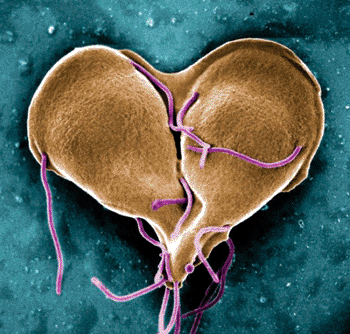Novel Molecular Assay Diagnoses Eight Gastrointestinal Parasites
By LabMedica International staff writers
Posted on 19 Aug 2013
A novel, rapid, high-throughput quantitative multiparallel real-time polymerase chain reaction (qPCR) platform has been developed for the diagnosis of gastrointestinal parasites. Posted on 19 Aug 2013
The diagnosis of gastrointestinal parasites has traditionally relied on stool microscopy, which has low diagnostic sensitivity and specificity as the ability of the microscopist to detect parasites is directly related to the number of organisms in the stool.

Image: Scanning electron micrograph of Giardia lamblia (Photo courtesy of Dr. Stan Erlandsen).
Helminthologists at the US National Institutes of Health (Bethesda, MD, USA) working with others, collected fecal samples from 400 asymptomatic children, 13 months of age, living in, Ecuador. The children were part of a larger ongoing birth cohort study in which direct microscopy and the Kato-Katz method were performed at the time of stool collection. A second group of 125 asymptomatic children eight to 14 years of age also had fecal samples collected as part of a separate study of anthelmintic treatment.
Species-specific primers/probes were used for eight common gastrointestinal parasite pathogens: Ascaris lumbricoides, Necator americanus, Ancylostoma duodenale, Giardia lamblia, Cryptosporidium spp., Entamoeba histolytica, Trichuris trichiura, and Strongyloides stercoralis. All qPCRs were conducted in 96-well MicroAmp optical plates (Applied Biosystems; Foster City, CA, USA) and the samples were run on Applied Biosystem’s ABI 7900HT Fast Real-Time PCR System and compared with a standard direct wet mount slide for stool microscopy.
The qPCR showed higher detection rates for all parasites compared with direct microscopy. For example, the molecular assay identified Ascaris in 28 of 400 (7.0%) of positive samples whereas direct smears identified 22 of 400 (5.5%) positive samples. The difference between qPCR and microscopy was seen even more dramatically for G. lamblia with 103 additional positive samples for this parasite with 126 of 400 (31.5%) with qPCR versus 23 of 400 (5.8%) by microscopy. The qPCR was able to distinguish between patients without parasites and those with polyparasitism more accurately and with greater detection rates than direct smear microscopy.
The authors concluded that the high throughput system that has been field tested in a resource-limited area provides a sensitive and specific approach to gastrointestinal parasitism and polyparasitism, with broad implications for community based therapies and methods for assessing efficacy of treatment. The study was published in the August 2013 edition of the American Journal of Tropical Medicine and Hygiene.
Related Links:
US National Institutes of Health
Applied Biosystems









 assay.jpg)




